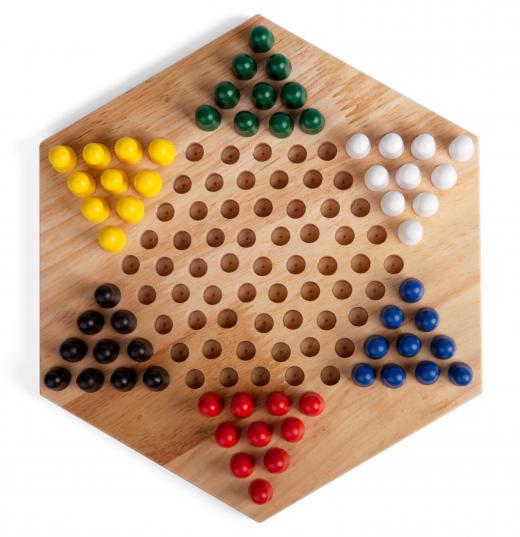Chinese checkers are neither checkers, nor Chinese. The simple game is popular with all ages, though. Chinese checkers are based on “Halma,” a game based loosely on the British board game “Hoppity.” Halma came into being in the 1870s-1880s in Britain. A German company modified the board into the familiar six-pointed star we know today and called it “Stern-Halma,” stern meaning “star.”
Chinese checkers evolved a little later, using the star-shaped board, and the game's current name appeared in the late 1920s. It tied in with the fad for all things Oriental. The game is still called Halma in Europe, where it is played more like the original game. Two to six players can play Chinese checkers. Each player has ten marbles placed in a like-colored point on the star, and the object of the game is to get all of one’s marbles across the board into the other player’s star point.

The most common way of playing is the “hop-across” method. Players move a single marble into one adjacent space on the board, or jump their own or their opponent’s marbles to move across. Those are the basics for playing. Winning the game is a bit more difficult. Chinese checkers requires focus and the ability to plan ahead, which may be the most crucial skill in winning the game.

Play begins when one player moves a marble a single space out from his triangle. The other player then moves, and the strategizing begins in earnest. The ability to jump one’s own and one’s opponent’s marbles without losing them as in regular checkers is a great help in getting across the board swiftly.
A good player will get all her marbles out of her triangle as quickly as possible, without worrying too much about getting them across the board. Once the marbles are out, she can then plan jumps and moves that are not possible with marbles left behind. A player can keep a single marble moving as long as there are adjacent marbles to jump.

One of the best features of Chinese checkers is the jumping. An experienced player can set up elaborate jumps that may take his marble all the way across the board in one move. He can only jump one marble at a time, not two together, but he can line his marbles up and jump each one, moving up the board toward the opponent’s space. This is when the ability to plan moves, and to see moves develop, is crucial. Good players learn to use opponents' marbles against them. A wise player is always thinking at least two moves ahead and watching for how her opponent’s moves will affect her plans, or even better them.

Back-up plans are also crucial in winning the game. If the opponent moves a marble out of position that will ruin a good trip across the board, the player has to plan for it and have something else in mind. He should first look to see if another move is possible, using the moved marble, and if it is a better move than originally planned. It is something of a psychological victory when the opponent saw the player’s move and deliberately spoiled it, and the player came up with something even better.
There is something very satisfying in planning and executing a cross-board jump that leaves the opponent’s mouth hanging open. It is also extremely frustrating to have one’s move spoiled, and a better one unavailable. The wise player must be able to assess her opponent’s tactical situation, what moves are open to the opponent, and which ones he is most likely to take. Everyone has a different playing style and different ideas on which moves will be most beneficial.
Chinese checkers is a good game for children, since it is so easily learned. It teaches fine motor skills and critical thinking skills, as well as cause-and-effect in a way that few other board games do. No scoring or dice are involved, so even a child who cannot count or add very well can play the game. It also allows a parent to help a child learn these skills in a fun way, providing quality time for both.
Chinese checkers sets are inexpensive, and may have a metal, wooden or plastic board. Some travel sets come with a vinyl-covered metal board and magnet pieces. In any manifestation, Chinese checkers is a fun and absorbing game that can be enjoyed by almost every member of the family.
